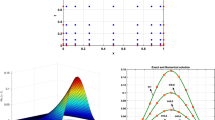Abstract
The eigenproblem of a symmetric tridiagonal matrix widely appears in physical applications and scientific computing. The classical solvers are the symmetric QR iteration, divide-and-conquer, bisection and inverse iteration, etc. For a symmetric tridiagonal matrix of dimension N, the cost of these methods scales at least as \(O(N^2)\). In this work, we present an efficient quantum algorithm for solving this problem through quantum simulation of resonant transitions. The cost of the algorithm can scale as \(poly(\log \,N)\), provided a good initial guess on the eigenstates of the system is obtained. By coupling a probe qubit to a quantum register that represents a system, resonance dynamics can be observed on the probe qubit when its frequency matches a transition frequency in the system. Energy eigenvalues of the system can be obtained by locating resonant transition frequencies between the probe qubit and transitions from a reference state to eigenstates of the system through observing dynamics of the probe qubit for different frequencies. And the system can be evolved to one of its eigenstate with known eigenvalue by inducing an appropriate resonant transition between the probe qubit and the system.


Similar content being viewed by others
References
Demmel, J.W.: Applied Numerical Linear Algebra. SIAM, Philadephia (1997)
Parlett, B.N.: The Symmetric Eigenvalue Problem. SIAM, Philadelphia (1998)
Golub, G.H., Van Loan, C.F.: Matrix Computations, 4th edn. The John Hopkins University Press, Baltimore (2013)
Cullum, J.K., Willoughby, R.A.: Lanczos Algorithms for Large Symmetric Eigenvalue Computations, Vol. I Theory, Birkhauser, Boston (1985), (reprinted by SIAM, 2002)
Trefethen, L.N., Bau, B.I.I.I.: Numerical Linear Algebra. SIAM, Philadephia (1997)
Cuppen, J.J.M.: A divide and conquer method for the symmetric tridiagonal eigenproblem. Numer. Math. 36, 177–195 (1981)
Dongarra, J.J., Sorensen, D.C.: A fully parallel algorithm for the symmetric eigenvalue problem. SIAM J. Sci. Stat. Comput. 8, s139–s154 (1987)
Gu, M., Eisenstat, S.C.: A divide-and-conquer algorithm for the symmetric tridiagonal eigenproblem. SIAM J. Matrix Anal. Appl. 16, 172–191 (1995)
Kitaev, A.: Quantum measurements and the Abelian Stabilizer Problem (1995). (arXiv:quant-ph/9511026)
Abrams, D.S., Lloyd, S.: Quantum algorithm providing exponential speed increase for finding eigenvalues and eigenvectors. Phys. Rev. Lett. 83, 5162–5165 (1999)
Aspuru-Guzik, A., Dutoi, A.D., Love, P.J., Head-Gordon, M.: Simulated quantum computation of molecular energies. Science 309, 1704 (2005)
Wang, H., Kais, S., Aspuru-Guzik, A., Hoffmann, M.R.: Quantum algorithm for obtaining the energy spectrum of molecular systems. Phys. Chem. Chem. Phys. 10, 5388–5393 (2008)
Wang, H.: Quantum algorithm for obtaining the eigenstates of a physical system. Phys. Rev. A 93, 052334 (2016)
Berry, D.W., Ahokas, G., Cleve, R., Sanders, B.C.: Efficient quantum algorithms for simulating sparse Hamiltonians. Commun. Math. Phys. 270, 359 (2007)
Berry, D.W., Childs, A.M., Cleve, R., Kothari, R., Somma, R.D.: Exponential improvement in precision for simulating sparse Hamiltonians. Forum of Mathematics, Sigma, Vol. 5, e8 (2017). (arXiv:1312.1414v2)
Berry, D.W., Childs, A.M., Cleve, R., Kothari, R., Somma, R.D.: Simulating Hamiltonian dynamics with a truncated Taylor series. Phys. Rev. Lett. 114, 090502 (2015)
Zhou, S.S., Wang, J.B.: Efficient quantum circuits for dense circulant and circulant-like operators. R. Soc. Open sci. 4, 160906 (2017)
Cuccaro, S.A., Draper, T.G., Kutin, S.A., Moulton, D.P.: A new quantum ripple-carry addition circuit (2004). (arXiv:quant-ph/0410184)
Draper, T.G., Kutin, S.A., Rains, E.M., Svore, K.M.: A logarithmic-depth quantum carry-lookahead adder (2004). (arXiv:quant-ph/0406142)
Low, G.H., Chuang, I.L.: Optimal Hamiltonian simulation by quantum signal processing. Phys. Rev. Lett. 118, 010501 (2017)
Aharonov, D., Ta-Shma, A.: In: Larmore L.L., Goemans M.X. (eds.) Proceedings of the Thirty-Fifth Annual ACM Symposium on Theory of Computing, STOC ’03, pp. 20–29. ACM, New York (2003)
Author information
Authors and Affiliations
Corresponding author
Additional information
Publisher's Note
Springer Nature remains neutral with regard to jurisdictional claims in published maps and institutional affiliations.
H. Wang is supported by the National Natural Science Foundation of China under Grants 11275145 and the Natural Science Fundamental Research Program of Shaanxi Province of China under Grants 2018JM1015, H. Xiang is supported by the National Natural Science Foundation of China under Grants 11571265 and NSFC-RGC No. 11661161017.
Rights and permissions
About this article
Cite this article
Wang, H., Xiang, H. A quantum eigensolver for symmetric tridiagonal matrices. Quantum Inf Process 18, 93 (2019). https://doi.org/10.1007/s11128-019-2211-z
Received:
Accepted:
Published:
DOI: https://doi.org/10.1007/s11128-019-2211-z




